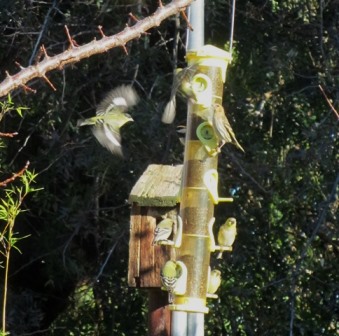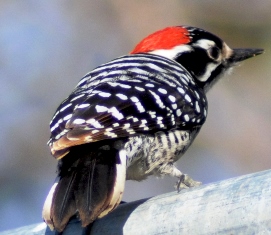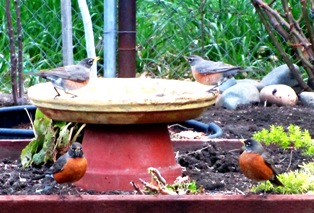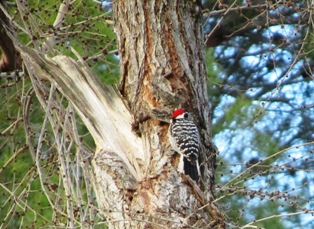Rainy Day Projects on the Farmette
I awoke in the pre-dawn hours to the sound of soft pattering of rain beyond my bedroom window. The birds twittered away in the pepper tree . I rolled over to listen and said a prayer of thanks that the “storm door” has finally opened. Three storms are expected to hit our drought-stricken California during this first full week of 2016.

There’s always plenty of action at the feeder when the finches discover it has been filled with Nyjer seed–high in calories and oil content.
After I had swallowed a half cup of morning coffee, I headed out to the feed store to buy chicken crumble, scratch grains, and some seed and suet to hang for the birds.

A male Nuttall’s Woodpecker loves dining on the suet cake; he hangs around all year near our pepper tree.
I won’t continue the pruning of the pomegranates and apricots that I started on Sunday. I’ll wait until we have a dry day for that. But I will continue to apply the plaster to the drywall that we’ve hung in the as-yet-unfinished small bedroom destined to become my office. That will be a perfect rainy day activity. And when I finish, I’ll go back to work on my newest mystery.
For more vignettes of farmette life, check out A Beeline to Murder, the first novel in the Henny Penny Farmette series of cozy mysteries. It’s available online and from brick-and-mortar bookstores everywhere. See, http://tinyurl.com/p8d6owd
Springtime Serenades from the Garden
The robins have arrived on the farmette. I’ve been moving dirt with the help of my husband and a worker and there are worms galore. If there’s anything a robin delights in more than dining on a fat, pink worm it surely is singing.
Throughout the morning, I hear its song–cheerily cheerily cheerily as it throws back its head and stands at attention in its red vest and gray-colored waistcoat.
The robin is one reason why I don’t believe in using insecticides for trees and lawns. Rains wash these contaminants into the soil, the earthworms eat the contaminated dirt, and the robins eat the worms. The cycle can be fatal for the birds.
High in an old elm tree with broken limbs and rot in places, a Nuttall’s Woodpecker adds its course drill of pr-r-r-r-rip to the robin’s song. What the woodpecker lacks in beautiful song, it more than makes up in its appearance. This fellow has a black-and-white striped face and back and a bar of black around its eye. Its cap is a vibrant splash of red.
These birds dine on insects from tree bark and frequently build their nests in a dead limb. Their clutch of white eggs hatch in about 14 days and the male shares responsibility with the female in incubating the eggs.
So while the work of moving dirt (so far, digging down to the septic to inspect and reinforce it and moving a section of dirt to the garden to replace an old gravel driveway) is tedious and time-consuming, the serenades of birds in the garden make the effort a bit more tolerable.
 Facebook
Facebook Goodreads
Goodreads LinkedIn
LinkedIn Meera Lester
Meera Lester Twitter
Twitter






